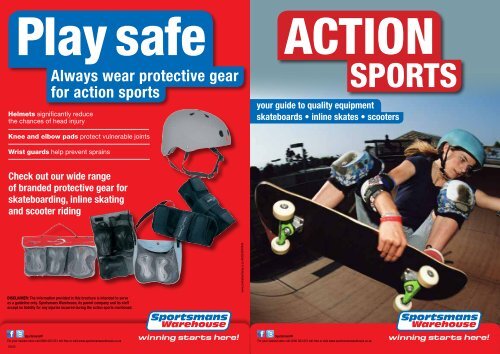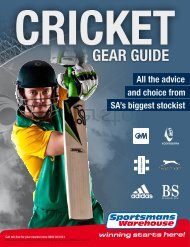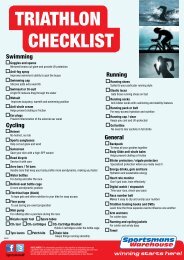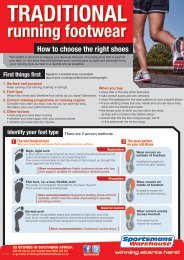Sportsmans Warehouse
Sportsmans Warehouse
Sportsmans Warehouse
Create successful ePaper yourself
Turn your PDF publications into a flip-book with our unique Google optimized e-Paper software.
Play safe<br />
always wear protective gear<br />
for action sports<br />
Helmets significantly reduce<br />
the chances of head injury<br />
Knee and elbow pads protect vulnerable joints<br />
Wrist guards help prevent sprains<br />
check out our wide range<br />
of branded protective gear for<br />
skateboarding, inline skating<br />
and scooter riding<br />
Disclaimer: The information provided in this brochure is intended to serve<br />
as a guideline only. <strong>Sportsmans</strong> <strong>Warehouse</strong>, its parent company and its staff<br />
accept no liability for any injuries incurred during the action sports mentioned.<br />
<strong>Sportsmans</strong>W<br />
For your nearest store call 0800 003 051 toll-free or visit www.sportsmanswarehouse.co.za<br />
E&OE<br />
www.zoomadvertising.co.za 48393/SPRT494<br />
ACTION<br />
SPORTS<br />
your guide to quality equipment<br />
skateboards • inline skates • scooters<br />
<strong>Sportsmans</strong>W<br />
For your nearest store call 0800 003 051 toll-free or visit www.sportsmanswarehouse.co.za
sKaTeBOarD components<br />
deck • grip tape • trucks • hardware • wheels • bearings<br />
Deck<br />
Material: Most decks are constructed from between 6- and 9-ply laminated wood -<br />
chinese maple (for entry-level boards) or canadian maple (for high-end boards). Some are strengthened<br />
with materials such as fibreglass, bamboo, resin, Kevlar, carbon fibre, aluminium and plastic.<br />
Size: Modern decks vary in size, but most are 7 to 10,5 inches (17,78 to 26,67 cm) wide. Your choice will be<br />
influenced by your foot size. Wider decks provide greater stability for transition or ramp skating. Narrower decks<br />
allow for quick rotation. Length of board varies between 28 and 33 inches (71,12 and 83,82 cm).<br />
The longboard, a common variant also called a cruiser, is mostly ridden down hills or on beachside pavements<br />
or boardwalks to mimic wave-riding.<br />
construction: A skateboard has an upturned nose and tail and a concave centre. The nose is usually longer and<br />
thicker than the tail. Both are called ‘kicktails’ and they are vital in manoeuvring the board, particularly for street<br />
skateboarding. They help with big tricks, pivots, slides, ollies (where rider and board leap into the air without the<br />
rider using his hands) and more.<br />
Wheelbase: The distance between the two sets of mounting holes drilled into the<br />
deck for the trucks is usually about 13 to 15 inches (33 to 38 cm). Taller people<br />
prefer a wider wheelbase, which lets them widen their stance while skating.<br />
wheelbase<br />
Grip tape<br />
This is a rough material that enables your feet to grip the deck. It has a surface like fine sandpaper on one side and<br />
adhesive on the other. Replacement grip tape is available in varying levels of coarseness. While it is usually black,<br />
other colours, as well as clear, are available. You can get creative and cut shapes<br />
into your grip tape, e.g. to show a graphic on the board underneath.<br />
truckS<br />
These connect the wheels to the deck and are usually made from aluminium alloy. Each skateboard has two trucks,<br />
each with two wheels. Trucks have tough, adjustable bushings which help the rider steer the board, as he or she<br />
applies more weight to one side of the deck.<br />
The baseplate of each truck is screwed to the deck and underneath it is the hanger,<br />
with the axle running through it. Between the two are bushings and rubbers or<br />
grommets. A kingpin holds these together and by tightening or loosening the kingpin nut,<br />
the trucks can either be loosened for better turning or tightened for increased stability.<br />
A variety of axle widths is available. Wider axles are used for wider boards.<br />
The special trucks for longboards have a kingpin at a more obtuse angle, which permits less turning for the same tilt<br />
of the deck, thus allowing riders to go faster, with a wider carving motion, while still keeping stable and in control.<br />
MountinG harDWare<br />
Eight 10-32 UNC bolts, usually with an Allen or Phillips head, together with matching nylon locknuts, are used to<br />
attach the trucks to the skateboard. Some sets may have one differently coloured bolt which indicates which side<br />
must face the nose of the skateboard.<br />
hanger<br />
baseplate<br />
kingpin<br />
axle<br />
grommet<br />
WheelS<br />
Size: The larger wheels (54 to 85 mm diameter) roll faster and cope<br />
better with cracks in the pavement. Smaller wheels (48 to 54 mm)<br />
keep the board closer to the ground, resulting in a lower centre of<br />
gravity. They need less force to accelerate.<br />
Material: Advanced polymers are used, usually polyurethane.<br />
Degree of hardness: This is measured by a Durometer and is mostly<br />
expressed as somewhere on the ‘A-scale’ which extends from 70 - 100.<br />
The higher the A-scale number, the harder the wheel. An average street<br />
skateboard wheel is 95A, and softer wheels can be 70A or even lower.<br />
Which wheel for your purpose?<br />
A good general choice is wheels between 52 and 54 mm, with 99A hardness.<br />
For riding ramps (or ‘verts’/vertical ramps) you want to roll much faster, so choose<br />
larger wheels (55 to 65 mm) with a hardness of 95-100A. (Start with 60 mm wheels.)<br />
Slalom skating demands the highest possible speeds, so choose even larger wheels<br />
of 60 to 75 mm, with a softer A rating. Longboarding/cruising and downhill<br />
skateboarding require large wheels (65 to 100 mm), which are softer (78A to 85A)<br />
for riding over rough terrain. For flip tricks many street/technical skateboarders prefer<br />
smaller wheels, which are lighter and closer to the ground, such as those 50 to 55 mm,<br />
with a hardness of 97A to 100A. A good all-terrain choice is a wheel size of<br />
52 to 60 mm, with 95A to 100A hardness, which gives a balance between speed<br />
and weight. In general 95A is an average wheel hardness for street skateboarding.<br />
BearinGS<br />
analyse<br />
the action<br />
A skateboard wheel is mounted on its axle by means of two bearings. These bearings are usually<br />
the standard 608 size and are made from steel, with a bore of 8 mm, an outer diameter of 22 mm<br />
and a width of 7 mm. Bearings enable the wheels to rotate freely at high speed and will have to be<br />
replaced occasionally. Do not skate in wet conditions, as this will ruin bearings.<br />
The ABEC scale for bearings:<br />
This is an American 1 – 9 scale for rating the accuracy of tolerance of bearings. (It does not measure<br />
how well a bearing will handle side-to-side loads, which can be severe with skateboard movement.)<br />
ABEC 3 applies to most inexpensive complete skateboards<br />
ABEC 5 is the norm for recreational skateboarding<br />
ABEC 7 bearings are very fast and smooth<br />
ABEC 9 bearings are extremely highly spec’d and are used in the most advanced boards<br />
optional coMponentS<br />
• risers increase the space between truck and deck, permitting the truck to twist further without causing the wheel<br />
to ‘bite’ the deck and stop turning.<br />
• rails or ribs are strips of plastic or metal affixed under the deck along its edges. Although rarely used today,<br />
they can provide the experienced skater with extra grip for grabs, they can enhance sliding, plus they can<br />
protect the graphics of the deck’s underside.<br />
• Wedges can be used to alter a truck’s turning characteristics.<br />
• Slip tape or ever-slick is a clear, self-adhesive plastic stuck to the deck’s underside for protection and easier sliding.<br />
E&OE
inline sKaTes components<br />
boot • frame/chassis • wheels • bearings • brakes<br />
Boot<br />
Material: Hard shell vs soft shell. Hard shell boots are not manufactured<br />
often these days, although they offered good support for large skaters<br />
and those with weak ankles. Soft boots are immediately comfortable<br />
and help to encourage starter skaters.<br />
liner: Before buying skates, check the liner by removing it and fitting<br />
it to your foot. It must be comfortable and secure. Then replace it<br />
and try on the whole boot. Superior liners are moisture-absorbent.<br />
All liners are washable.<br />
Foot bed: This is removable and washable and is placed inside the liner to cradle the foot.<br />
You can replace the foot bed with an orthotic which has been custom-made for you, or another support<br />
bought in-store.<br />
laces: These are minutely adjustable, but they can loosen as you skate.<br />
Buckles: These are permanently attached to the skate and offer good, consistent support.<br />
Adjust them until they are right for you and they will be ready for a quick start, every time.<br />
laces plus buckles: These are found in some recreational and fitness skates, with the buckle (or a Velcro strap)<br />
surrounding the ankle area and the laces over the top of the foot.<br />
FraMe or chaSSiS<br />
Material:<br />
Polypropylene: Many recreational skates have frames<br />
made of this versatile thermoplastic.<br />
Polyurethane is also used.<br />
Aluminium: This is more expensive and sturdier<br />
than polypropylene.<br />
Other metals: Magnesium and titanium alloys are also used.<br />
Other materials: Nylon/fibreglass and carbon.<br />
Lighter materials reduce fatigue. Aluminium is lighter than plastic and carbon is even lighter.<br />
important attributes:<br />
The frame must be light, but strong and rigid. If a frame is too flexible, the energy of the stroke is dissipated<br />
and much of it is wasted. In addition, the frame must be attached securely to the boot and its alignment must<br />
be correct so that the wheels track properly. Certain frames allow for ‘rockering’, i.e. adjusting the two middle<br />
wheels downward to facilitate quick turns and pivots. Some frames also allow you to adjust to larger wheels<br />
as your skill increases.<br />
brake<br />
wheels frame<br />
WheelS<br />
Diameter size: This depends on skating style. Generally, the greater<br />
the diameter, the faster the wheel can move. However, smaller wheels<br />
provide faster acceleration and manoeuvrability, plus the stability<br />
of a lower centre of gravity.<br />
44 – 59 mm for aggressive skating<br />
68 – 72 mm for artistic inline skating<br />
47 – 80 mm for roller hockey skating<br />
72 – 80 mm for freestyle slalom skating and downhill skating<br />
72 – 90 mm for general recreational skating<br />
84 – 110 mm for speed skating<br />
Core: This varies from solid (i.e. no spokes) for aggressive wheels,<br />
to extremely light spoke designs for racing wheels.<br />
Profile: This means the shape of the wheel, which determines how much the wheel makes<br />
contact with the ground. Elliptical profiles (taller, thinner, more tapered) cause less friction<br />
and thus provide a faster ride. More rounded shapes are more stable and grip better, which<br />
is good for hockey. Recreational wheels are of average height, with an average taper.<br />
Number: Downhill skates normally have five or six wheels for stability at high speed.<br />
Recreational skates usually have four wheels.<br />
Material: Almost all are made from polyurethane, a durable plastic.<br />
Degree of hardness: This is measured by a Durometer and is mostly expressed as somewhere on the ‘A-scale’ which<br />
extends from 70 - 100. The higher the A-scale number, the harder the wheel. Harder wheels go faster and are more<br />
durable, but a softer wheel material might be one of the factors contributing to a wheel’s grip. Most recreational skate<br />
wheels vary from 78A to 82A. Wheels for aggressive skating may go up into the 90As.<br />
BearinGS<br />
The ABEC scale for bearings:<br />
This is an American 1 – 9 scale for rating the accuracy of tolerance of bearings.<br />
ABEC 5 is the norm for recreational skating<br />
ABEC 7 bearings are very fast and smooth<br />
ABEC 9 bearings are extremely highly spec’d<br />
Rollerblade now use their own rating system, from SG-1 to SG-9.<br />
Each wheel has two bearings, which fit into openings moulded into each side<br />
of the wheel hub, where a flange holds them the correct distance apart.<br />
BrakeS<br />
enhance<br />
the experience<br />
profile core<br />
Unlike the front brake of roller skates, the hard rubber brake on inline skates is attached<br />
to the heel of the frame. The skater brakes by lifting the toe of the skate, and special lessons<br />
in braking are required. A feature called ABT (Advanced Braking Technology) can be useful,<br />
but tends to wear the brake pad down. (Most aggressive inline skates and racing skates have no heel brake.)<br />
diameter<br />
E&OE
KicK scOOTer components<br />
deck • head tube • headset • grip tape • fork • handlebars • wheels • bearings • brakes • folding action<br />
Deck<br />
Material: Most of the modern, urban kick scooters have decks made from lightweight<br />
aluminium or steel. Quality scooters are made from 100% aircraft-grade<br />
aluminium. Some do, however, have wood laminate or wood-and-fibreglass<br />
laminate decks. A urethane cushion might be placed between the deck and the frame for shock-absorption.<br />
Size: Decks range in length between about 16 and 23 inches (40 and 58 cm) and the most common widths are<br />
4½” and 4” (11,5 and 10 cm). Wider decks suit bigger riders with bigger feet, while narrower decks are easier<br />
to handle for the smaller or inexperienced rider. Cruiser kick scooters are wider, offering more foot space and a<br />
smooth ride. Some children’s scooters have wider decks for stability.<br />
construction: Scooters used for tricks can have decks that are reinforced, thicker and double-welded to the<br />
down-tube. All scooters are rated to carry up to certain maximum weights of rider.<br />
heaD tuBe<br />
This is the front part of the deck where the fork and bars are mounted. Head tubes are available in several<br />
angles to provide a choice of feel when riding.<br />
heaDSet<br />
This component is fitted into the head tube and is designed to keep the fork on the scooter.<br />
It can be threaded or threadless and the kind of headset you choose will determine the<br />
kind of fork you can ride.<br />
Grip tape<br />
This rough material must be applied, just as on a skateboard, to help your feet grip the deck.<br />
Fork<br />
The fork fits into the head tube. Forks can be threaded or threadless. Aluminium forks are usually<br />
fork<br />
threadless, while steel forks are usually threadless but can be threaded. The handlebar piece is<br />
fitted into the fork and kept in place with a collar clamp, which must be strong and solid, particularly<br />
for tricks. Double, triple and quadruple clamps are available. The fork is compatible with the wheel size.<br />
hanDleBarS<br />
pieces: One-piece and three-piece bars are available. One-piece bars are usually made<br />
from 4130 chromoly steel, but aluminium bars are beginning to appear.<br />
headset<br />
height adjustment: Many handlebars are adjustable from 22 up to 36 inches (56 to 91 cm) and can be moved<br />
by means of a quick-release or push pin. Some scooters offer a choice of fixed-height (and width) handlebars.<br />
The ideal height for handlebars is at the level of the rider’s navel.<br />
Steering: Most scooters have T-style handlebars which you turn to steer the scooter. Some scooters have fixed<br />
handlebars which only serve to balance the rider, who has to lean in order to turn the scooter. Others have ballstyle<br />
handlebars with a simple rubber ball-grip, serving to balance the rider who rides the scooter surfer-style,<br />
leaning side-to-side to turn.<br />
Grips: These are usually soft rubber. Some have extra-thick foam padding, while other, high-end trick scooters<br />
have low-profile grips to enhance mobility.<br />
clamp<br />
bar<br />
head tube<br />
grip<br />
clamp<br />
folding mechanism<br />
deck<br />
WheelS<br />
Size: Diameters start at about 110 mm and<br />
go up to just over 200 mm, depending on<br />
the size and design of the scooter.<br />
Smaller wheels go reasonably fast and smoothly and are<br />
more suitable for tricks. Larger wheels will cope with uneven<br />
pavements more easily, but are not recommended for tricks.<br />
Material: Smaller (standard) wheels are usually made of<br />
solid polyurethane with a small hub. Larger wheels generally<br />
have a spoked metal construction covered by a thin, polyurethane tyre.<br />
BearinGS<br />
Each wheel has two bearings and a bearer spacer in the middle to prevent<br />
damage from over-tightening.<br />
Replacement bearings are available in sets of four. The American ABEC scale for<br />
bearings applies, with higher ratings providing faster rolling with less friction.<br />
ABEC 5 is the norm for many kick scooters<br />
ABEC 7 bearings are used in some highly spec’d trick scooters<br />
BrakeS<br />
The most common is a very simple fender brake.<br />
The rider steps on the rear fender which is mounted on a hinged spring,<br />
then the fender presses against the wheel to stop it.<br />
grip tape<br />
FolDinG action<br />
brake<br />
Most scooters fold up quickly and easily. Simply unlock the joint<br />
release lever, fold the scooter and re-lock the mechanism to hold<br />
the scooter in the folded position. Compact folded size and light<br />
weight make these scooters extremely portable.<br />
Pro scooters used for tricks are typically not foldable.<br />
three-WheeleD DeSiGn<br />
wheel with bearings<br />
smooth<br />
your ride<br />
These scooters are suitable for younger children, as they are more stable,<br />
closer to the ground and have an easy stick steering mechanism.<br />
E&OE







